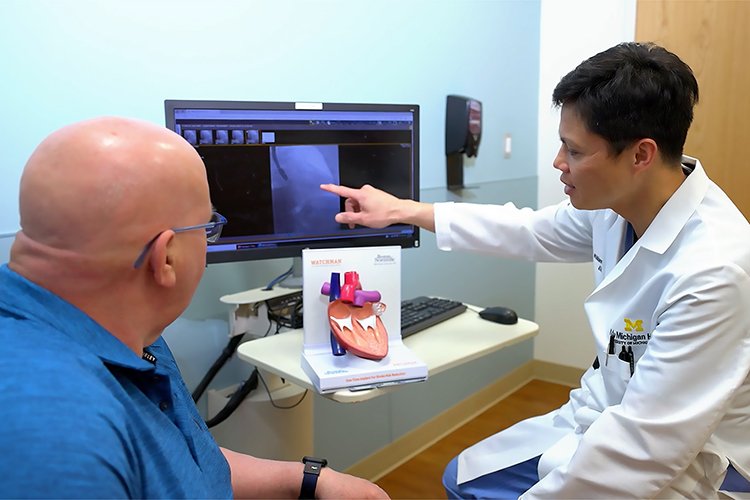Advanced Heart Procedure Minimizes AFib-Related Stroke Risk

Electrophysiologist William Mellana Jr., M.D., explains the WATCHMAN procedure to Michael Fowler.
Minimizing the risk of bleeding and stroke are the goals for patients requiring long-term blood thinners to treat non-valvular atrial fibrillation (AFib). At MyMichigan Health, an advanced, minimally-invasive procedure referred to as WATCHMAN offers AFib patients an alternative to long-term blood thinners. For Michael Fowler, age 59, it was the answer to ending a 25-year reliance on blood thinners to keep his AFib under control.
Fowler’s wife shared that she read that MyMichigan was offering WATCHMAN procedures to patients who qualified, and he was intrigued. “I have been on medication for AFib for so many years,” Fowler shared. “I work with mentally handicapped individuals, and that can get very physical at times. I also had a bike accident last year that scared me, so I wanted to look at options that would lessen my risks for an incident where bleeding would be very dangerous for me.”
During a follow-up appointment, Fowler’s Family Medicine Physician Eric Becker, M.D., connected him to Electrophysiologist William Michael Mellana Jr., M.D., for an evaluation. “Dr. Becker knew my personal and family history; my father had two heart attacks by the time he was my age. I want to be around for a long time, and I was hopeful to be approved for the procedure.”
The WATCHMAN FLX™ Left Atrial Appendage Closure (LAAC) is implanted into the heart during a one-time procedure to reduce the risk of AFib-related stroke. The implant device closes off an area of the heart called the left atrial appendage (LAA) to keep harmful blood clots that can form there from entering the blood stream and potentially cause a stroke.
“To implant the WATCHMAN device, we make a small cut in the upper leg and insert a narrow catheter tube, as would be done in a standard stent procedure,” explained Dr. Mellana. “We then guide the WATCHMAN through the femoral vein into the left atrial appendage of the heart. The procedure is done under general anesthesia and only takes about an hour. It is a permanent device that never needs to be replaced, so it can be a great option for some patients who have a lifestyle, occupation or a condition that puts them at risk for serious bleeding.”
Fowler reports to healing nicely with no post-surgical issues and is feeling great. He also stated that the care he received in the hospital was stellar. “Everyone was great, so kind and caring. “I knocked my leads off a few times, and someone was always there to help me,” he shared. “Dr. Mellana is an asset to MyMichigan, and everyone else I encountered – the pre-operative nurse who stayed with me, my anesthetist, the technicians, the nurses and their aides – were all fantastic,” he added.
Now Fowler is working, and playing, worry-free. “I have all the faith in the world in MyMichigan’s doctors. Their expertise along with the care and kindness we receive from the entire team are the reasons we keep coming to the Medical Center in Midland for our care,” he said.
Those who would like more information about the WATCHMAN procedure, may visit www.mymichigan.org/watchman.
